SmS/EuS/SmS Tri-Layer Thin Films: The Role of Diffusion in the Pressure Triggered Semiconductor-Metal Transition
Abstract
1. Introduction
2. Materials and Methods
3. Results
3.1. Individual SmS and EuS Thin Films
3.2. Deposition and Annealing of Tri-Layers
3.3. Piezoresistive Behavior
3.4. XPS Analysis
4. Conclusions
Author Contributions
Funding
Acknowledgments
Conflicts of Interest
References
- Solomon, P.M.; Bryce, B.A.; Kuroda, M.A.; Keech, R.; Shetty, S.; Shaw, T.M.; Copel, M.; Hung, L.W.; Schrott, A.G.; Armstrong, C.; et al. Pathway to the Piezoelectronic Transduction Logic Device. Nano Lett. 2015, 15, 2391–2395. [Google Scholar] [CrossRef] [PubMed]
- Magdau, I.B.; Liu, X.H.; Kuroda, M.A.; Shaw, T.M.; Crain, J.; Solomon, P.M.; Newns, D.M.; Martyna, G.J. The piezoelectronic stress transduction switch for very large-scale integration, low voltage sensor computation, and radio frequency applications. Appl. Phys. Lett. 2015, 107, 073505. [Google Scholar] [CrossRef]
- Josephine, B.C.; Hiroyuki, M.; Matthew, C.; Paul, M.S.; Xiao-Hu, L.; Thomas, M.S.; Alejandro, G.S.; Lynne, M.G.; Glenn, J.M.; Dennis, M.N. First realization of the piezoelectronic stress-based transduction device. Nanotechnology 2015, 26, 375201. [Google Scholar]
- Jiang, Z.; Kuroda, M.A.; Tan, Y.; Newns, D.M.; Povolotskyi, M.; Boykin, T.B.; Kubis, T.; Klimeck, G.; Martyna, G.J. Electron transport in nano-scaled piezoelectronic devices. Appl. Phys. Lett. 2013, 102, 193501. [Google Scholar] [CrossRef]
- Wachter, P.; Jung, A.; Steiner, P. Pressure-driven metal-insulator transition in La-doped SmS—Excitonic Condensation. Phys. Rev. B 1995, 51, 5542–5545. [Google Scholar] [CrossRef] [PubMed]
- Jayarama, A.; Narayana, V.; Bucher, E.; Maines, R.G. Continuous and discontinuous semiconductor-metal transition in samarium monochalcogenides under pressure. Phys. Rev. Lett. 1970, 25, 1430. [Google Scholar] [CrossRef]
- Domingo, N.; Lopez-Mir, L.; Paradinas, M.; Holy, V.; Zelezny, J.; Yi, D.; Suresha, S.J.; Liu, J.; Serrao, C.R.; Ramesh, R.; et al. Giant reversible nanoscale piezoresistance at room temperature in Sr2IrO4 thin films. Nanoscale 2015, 7, 3453–3459. [Google Scholar] [CrossRef]
- Sousanis, A.; Smet, P.F.; Poelman, D. Samarium Monosulfide (SmS): Reviewing Properties and Applications. Materials 2017, 10, 953. [Google Scholar] [CrossRef]
- Hickey, C.F.; Gibson, U.J. Optical response of switching SmS in thin films prepared by reactive evaporation. J. Appl. Phys. 1987, 62, 3912. [Google Scholar] [CrossRef]
- Imura, K.; Matsubayashi, K.; Suzuki, H.S.; Deguchi, K.; Sato, N.K. Thermodynamic and transport properties of SmS under high pressure. Phys. B 2009, 404, 3028–3031. [Google Scholar] [CrossRef]
- Sousanis, A.; Poelman, D.; Stewart, M.; Rungger, I.; Nielen, L.; Schmitz-Kempen, T.; Depla, D.; Smet, P.F. Controlling the piezoresistance hysteresis in SmS thin films. Unpublished work.
- Sharenkova, N.V.; Kaminskii, V.V.; Golubkov, A.V.; Romanova, M.V.; Stepanov, N.N. Mechanism of stabilization of the Sm1-xGdxS metallic modification at the pressure-induced semiconductor-metal phase transition. Phys. Solid State 2009, 51, 1700–1702. [Google Scholar] [CrossRef]
- Jayaraman, A.; Bucher, E.; Dernier, P.D.; Longinotti, L.D. Temperature induced explosive first order electronic phase transition in Gd-doped Sms. Phys. Rev. Lett. 1973, 31, 700–703. [Google Scholar] [CrossRef]
- Jarrige, I.; Yamaoka, H.; Rueff, J.P.; Lin, J.F.; Taguchi, M.; Hiraoka, N.; Ishii, H.; Tsuei, K.D.; Imura, K.; Matsumura, T.; et al. Unified understanding of the valence transition in the rare-earth monochalcogenides under pressure. Phys. Rev. B 2013, 87, 115107. [Google Scholar] [CrossRef]
- Antonov, V.N.; Harmon, B.N.; Yaresko, A.N. Electronic structure of mixed-valence semiconductors in the LSDA+U approximation. I. Sm monochalcogenides. Phys. Rev. B 2002, 66, 165208. [Google Scholar] [CrossRef]
- Jayaraman, A.; Maines, R.G. Study of the valence transition in Eu-, Yb-, and Ca-substituted SmS under high pressure and some comments on other substitutions. Phys. Rev. B 1979, 19, 4154–4161. [Google Scholar] [CrossRef]
- Robinson, J.M. Valence transitions and intermediate valence states in rare earth and actinide materials. Phys. Rep. 1978, 51, 1–62. [Google Scholar] [CrossRef]
- Takenaka, K.; Asai, D.; Kaizu, R.; Mizuno, Y.; Yokoyama, Y.; Okamoto, Y.; Katayama, N.; Suzuki, H.S.; Imanaka, Y. Giant isotropic negative thermal expansion in Y-doped samarium monosulfides by intra-atomic charge transfer. Sci. Rep. 2019, 9, 122. [Google Scholar] [CrossRef]
- Solomon, P.M.; Bryce, B.; Keech, R.; Shaw, T.M.; Copel, M.; Hung, L.W.; Schrott, A.; Theis, T.N.; Haensch, W.; Rossangel, S.M.; et al. The PiezoElectronic switch: A path to low energy electronics. In Proceedings of the 2013 Third Berkeley Symposium on Energy Efficient Electronic Systems (E3S), Berkeley, CA, USA, 28–29 October 2013; pp. 1–2. [Google Scholar]
- Baek, S.H.; Park, J.; Kim, D.M.; Aksyuk, V.A.; Das, R.R.; Bu, S.D.; Felker, D.A.; Lettieri, J.; Vaithyanathan, V.; Bharadwaja, S.S.N.; et al. Giant Piezoelectricity on Si for Hyperactive MEMS. Science 2011, 334, 958–961. [Google Scholar] [CrossRef]
- Chen, L.; Lee, H.; Guo, Z.J.; McGruer, N.E.; Gilbert, K.W.; Mall, S.; Leedy, K.D.; Adams, G.G. Contact resistance study of noble metals and alloy films using a scanning probe microscope test station. J. Appl. Phys. 2007, 102, 074910. [Google Scholar] [CrossRef]
- Poulopoulos, P.; Goschew, A.; Kapaklis, V.; Wolff, M.; Delimitis, A.; Wilhelm, F.; Rogalev, A.; Pappas, S.D.; Straub, A.; Fumagalli, P. Induced spin-polarization of EuS at room temperature in Ni/EuS multilayers. Appl. Phys. Lett. 2014, 104, 112411. [Google Scholar] [CrossRef]
- Poulopoulos, P.; Lewitz, B.; Straub, A.; Pappas, S.D.; Droulias, S.A.; Baskoutas, S.; Fumagalli, P. Band-gap tuning at the strong quantum confinement regime in magnetic semiconductor EuS thin films. Appl. Phys. Lett. 2012, 100, 211910. [Google Scholar] [CrossRef]
- Rogers, E. Engineering the Electronic Structure of Lanthanide Based Materials. Ph.D. Thesis, TUDelft, Delft, The Netherlands, 2012. [Google Scholar]
- Rogers, E.; Smet, P.F.; Dorenbos, P.; Poelman, D.; van der Kolk, E. The thermally induced metal-semiconducting phase transition of samarium monosulfide (SmS) thin films. J. Phys. Condens Matter 2010, 22, 015005. [Google Scholar] [CrossRef] [PubMed]
- Sousanis, A.; Smet, P.F.; Detavernier, C.; Poelman, D. Stability of switchable SmS for piezoresistive applications. In Proceedings of the IEEE Nanotechnology Materials and Devices Conference (NMDC), Toulouse, France, 9–12 October 2016. [Google Scholar] [CrossRef]
- Zenkevich, A.V.; Parfenov, O.E.; Storchak, V.G.; Teterin, P.E.; Lebedinskii, Y.Y. Highly oriented metallic SmS films on Si(100) grown by pulsed laser deposition. Thin Solid Film. 2011, 519, 6323–6325. [Google Scholar] [CrossRef]
- Yang, Q.I.; Zhao, J.; Zhang, L.; Dolev, M.; Fried, A.D.; Marshall, A.F.; Risbud, S.H.; Kapitulnik, A. Pulsed laser deposition of high-quality thin films of the insulating ferromagnet EuS. Appl. Phys. Lett. 2014, 104, 082402. [Google Scholar] [CrossRef]
- Ananth, K.P.; Gielisse, P.J.; Rockett, T.J. Synthesis and characterization of europium sulfide. Mater. Res. Bull. 1974, 9, 1167–1171. [Google Scholar] [CrossRef]
- Gour, A.; Singh, S.; Singh, R.K. Theoretical analysis of pressure-induced phase transition of EuS and EuSe including the role of temperature. J. Alloy. Compd. 2009, 468, 438–442. [Google Scholar] [CrossRef]
- Schmiester, G.; Wortmann, G.; Kaindl, G.; Bach, H.; Holtzberg, F. Pressure-induced valence changes in EuS and SmTe. High Press. Res. 1990, 3, 192–194. [Google Scholar] [CrossRef]
- Sousanis, A.; Poelman, D.; Detavernier, C.; Smet, P.F. Switchable piezoresistive SmS thin films on large area. Sensors 2019, 19, 4390. [Google Scholar] [CrossRef]
- Busch, G.; Guntherodt, G.; Wachter, P. Optical transitions and the energy level scheme of the europium chalcogenides. J. Phys. Colloq. 1971, 32, C1-928–C1-929. [Google Scholar] [CrossRef]
- Kaminskii, V.V.; Stepanov, N.N.; Kazanin, M.M.; Molodykh, A.A.; Solov’ev, S.M. Electrical conductivity and band structure of thin polycrystalline EuS films. Phys. Solid State 2013, 55, 1074–1077. [Google Scholar] [CrossRef]
- Kaminskii, V.V.; Solov’ev, S.M.; Khavrov, G.D.; Sharenkova, N.V.; Hirai, S. Structural features of Sm1–xEuxS thin polycrystalline films. Semiconductors 2017, 51, 828–830. [Google Scholar] [CrossRef]
- Kim, H.-T.; Chae, B.-G.; Youn, D.-H.; Maeng, S.-L.; Kim, G.; Kang, K.-Y.; Lim, Y.-S. Mechanism and observation of Mott transition in VO2-based two- and three-terminal devices. New J. Phys. 2004, 6, 52. [Google Scholar] [CrossRef]
- Di Sante, D.; Fratini, S.; Dobrosavljević, V.; Ciuchi, S. Disorder-Driven Metal-Insulator Transitions in Deformable Lattices. Phys. Rev. Lett. 2017, 118, 036602. [Google Scholar] [CrossRef] [PubMed]
- Möbius, A. The metal-insulator transition in disordered solids: How theoretical prejudices influence its characterization A critical review of analyses of experimental data. Crit. Rev. Solid State Mater. Sci. 2019, 44, 1–55. [Google Scholar] [CrossRef]
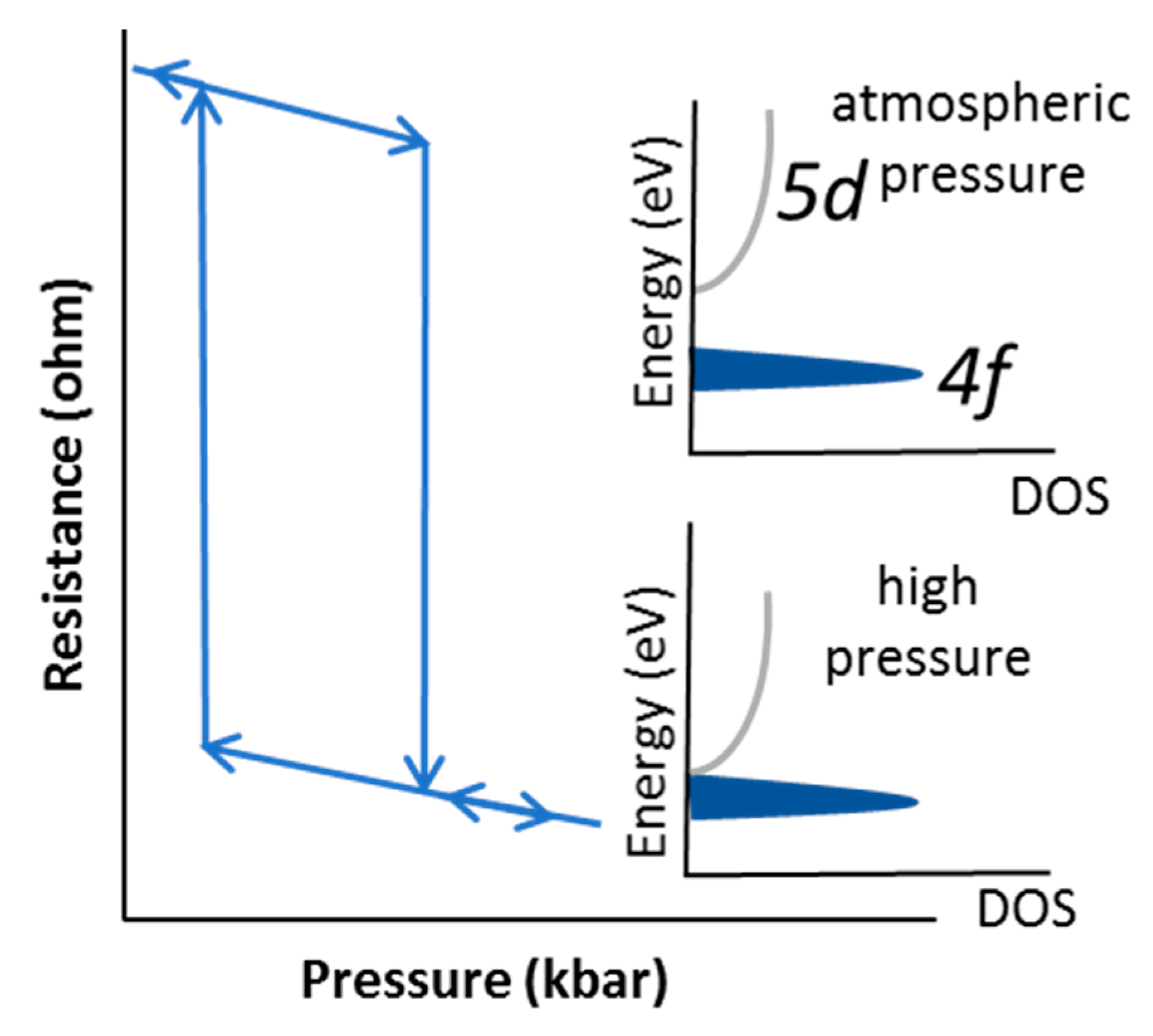
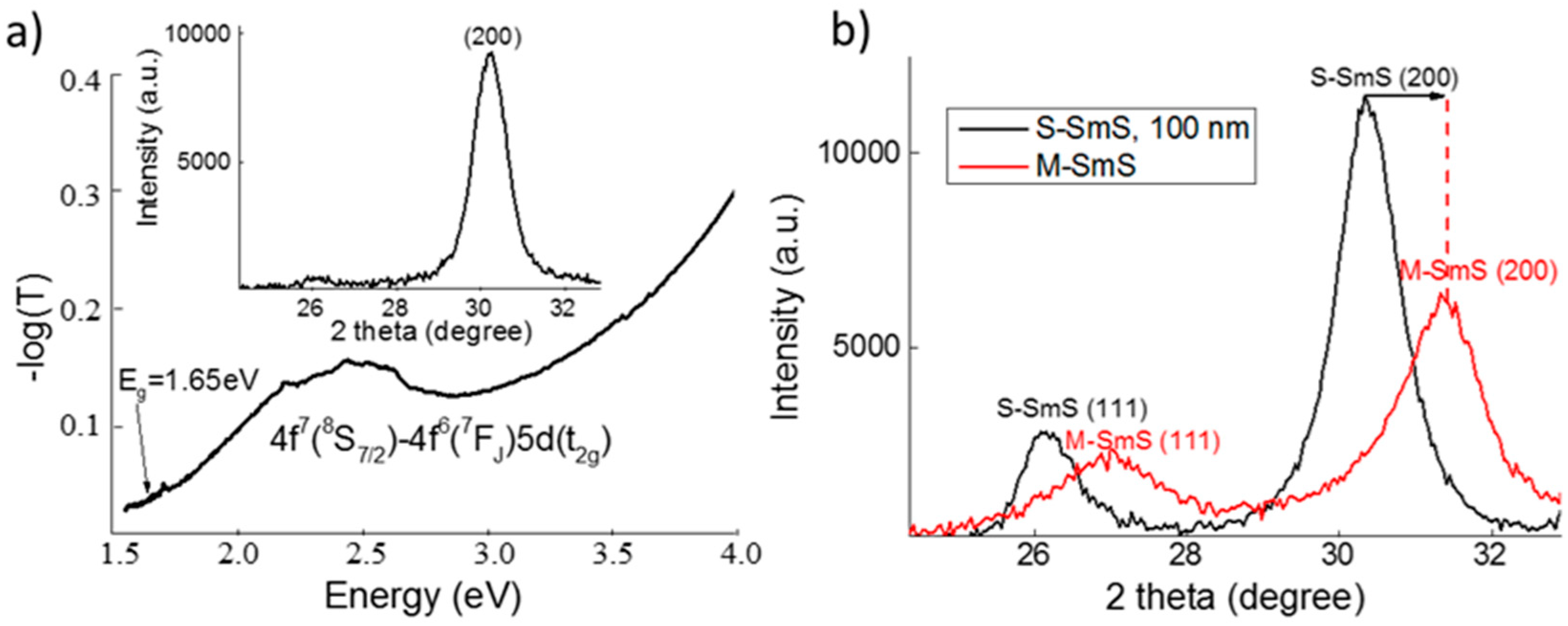
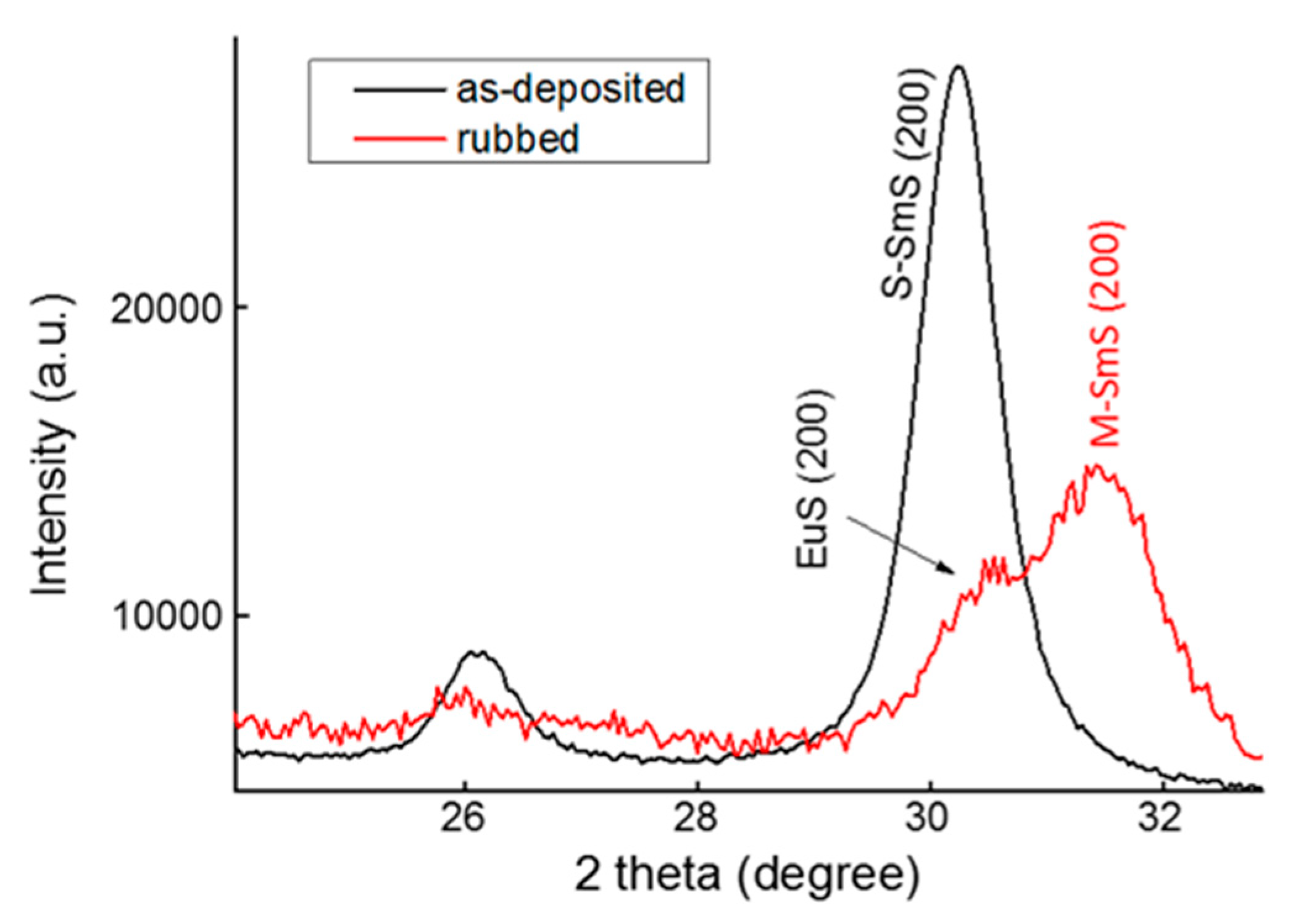
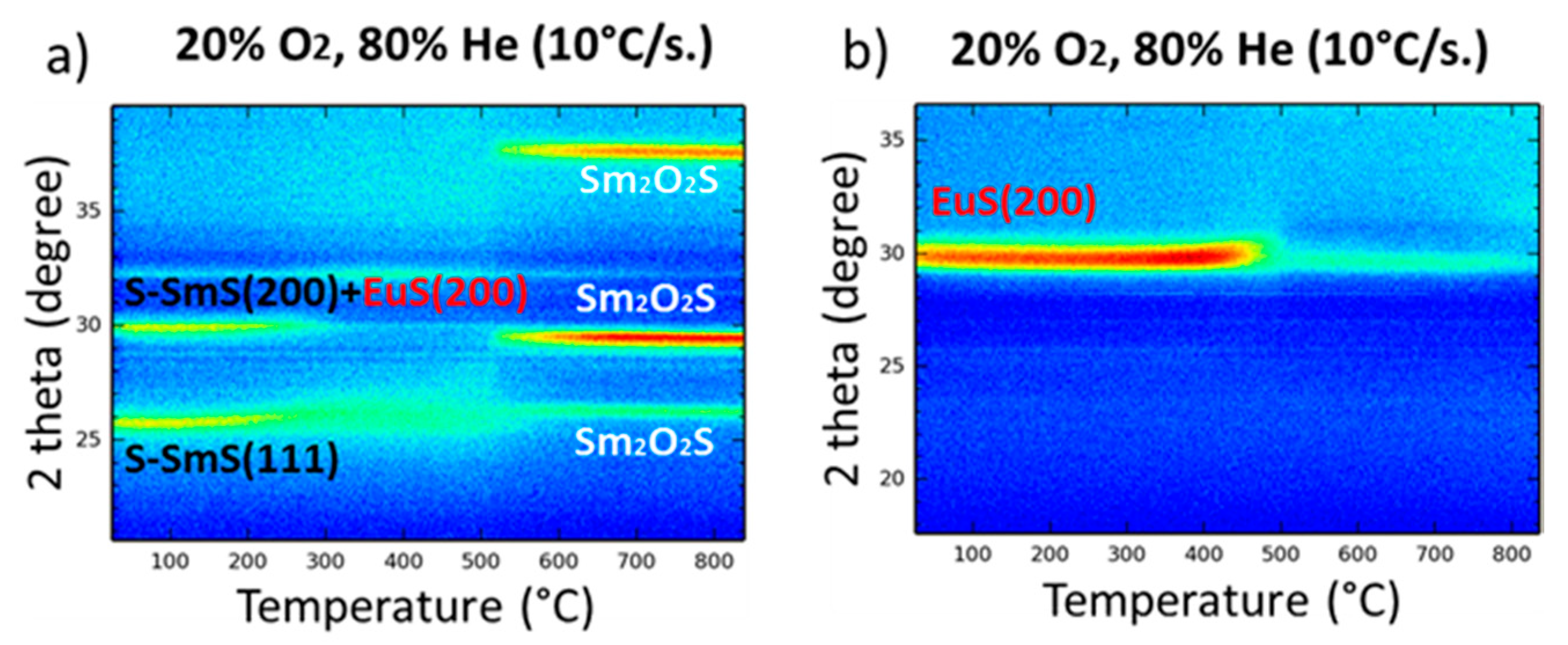
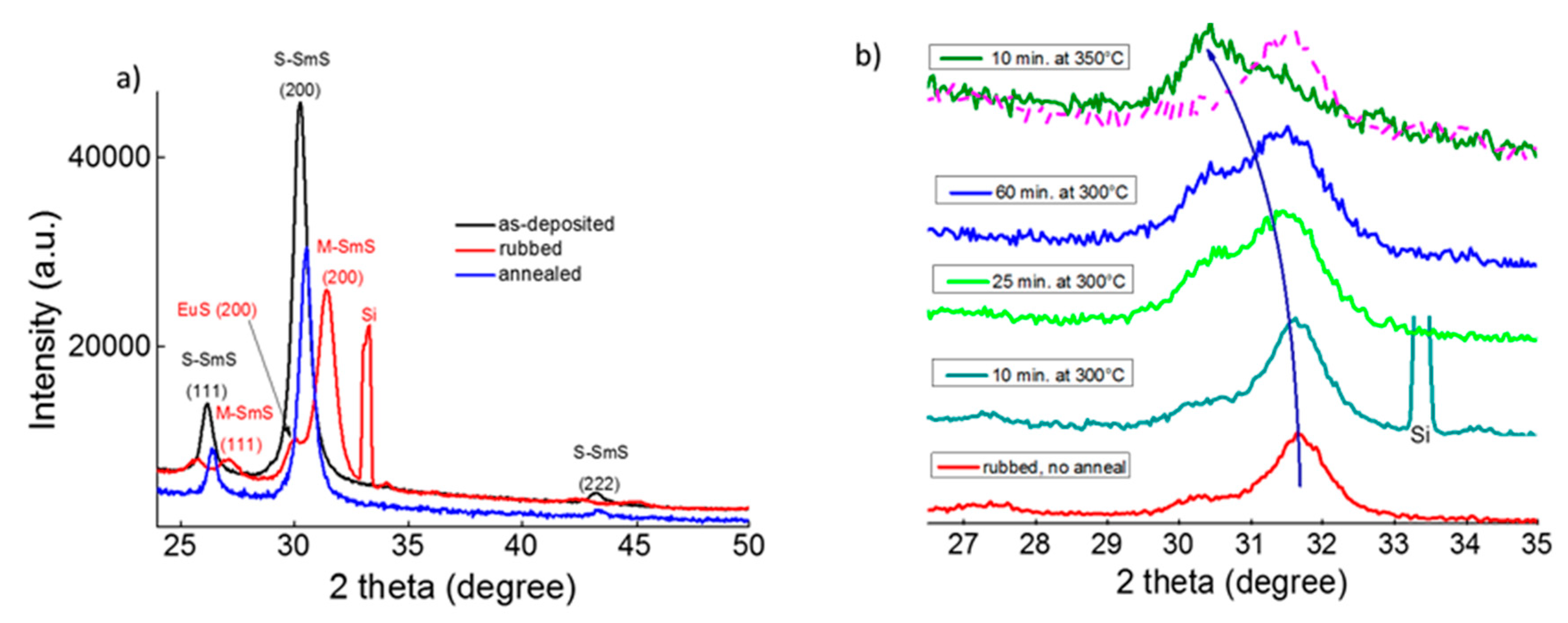
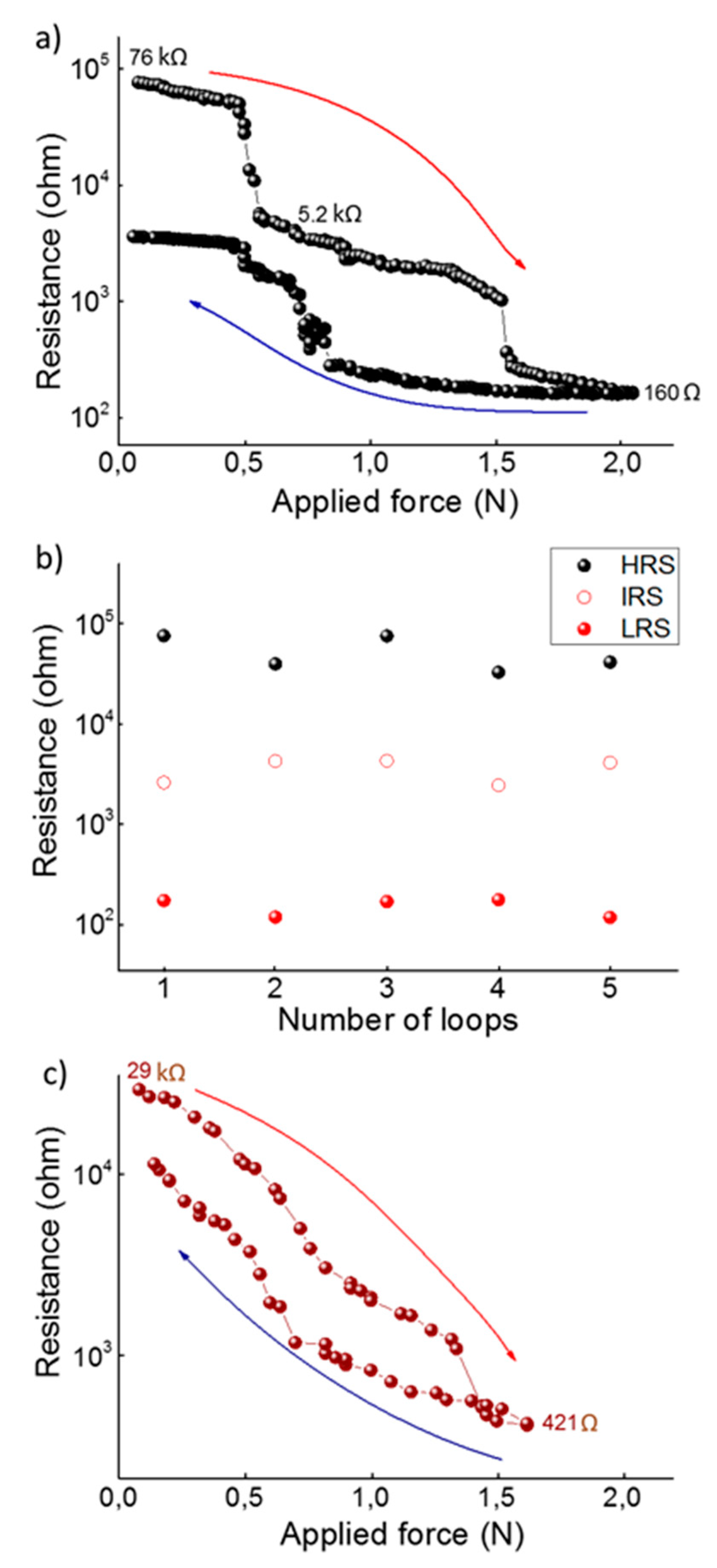
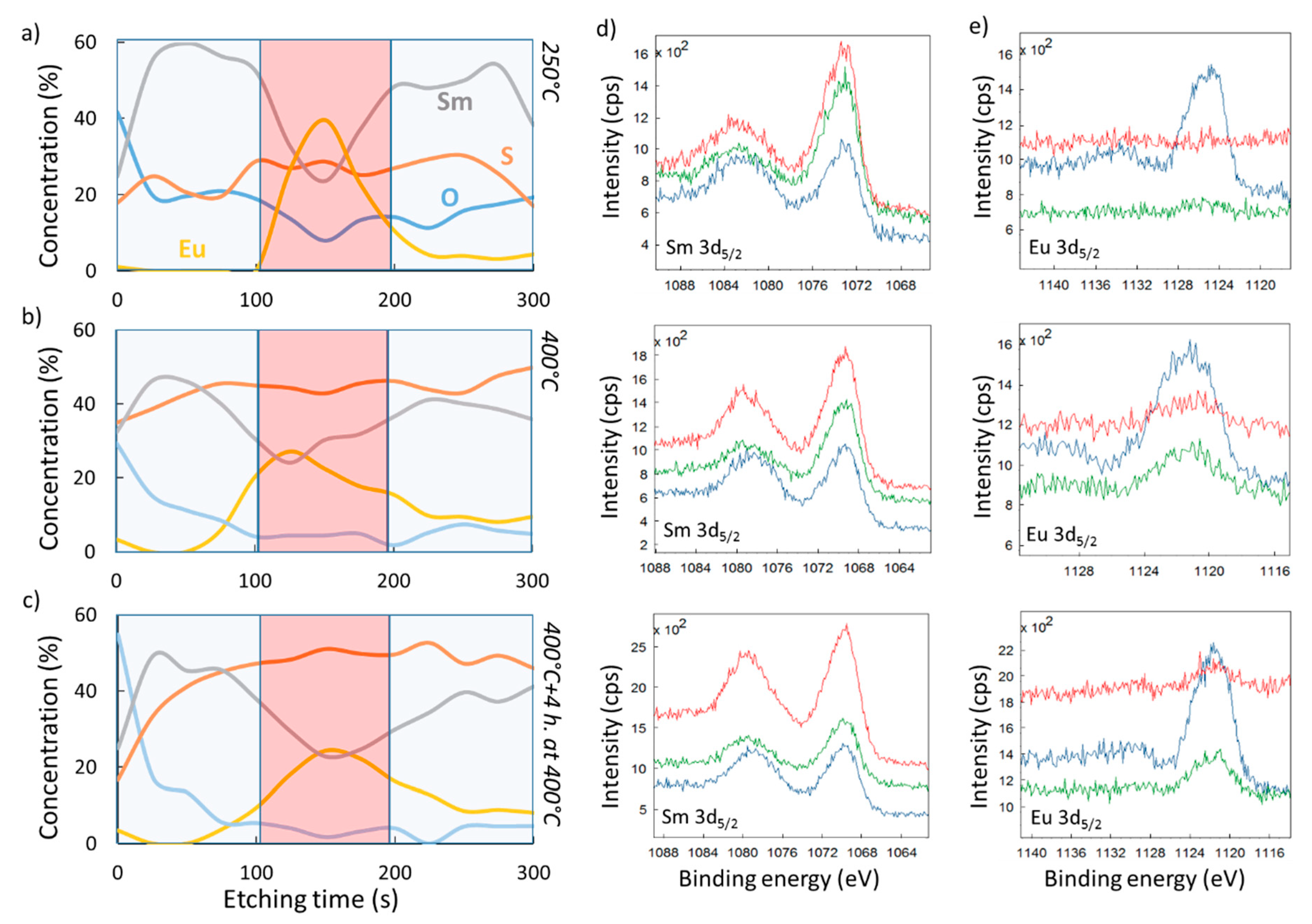
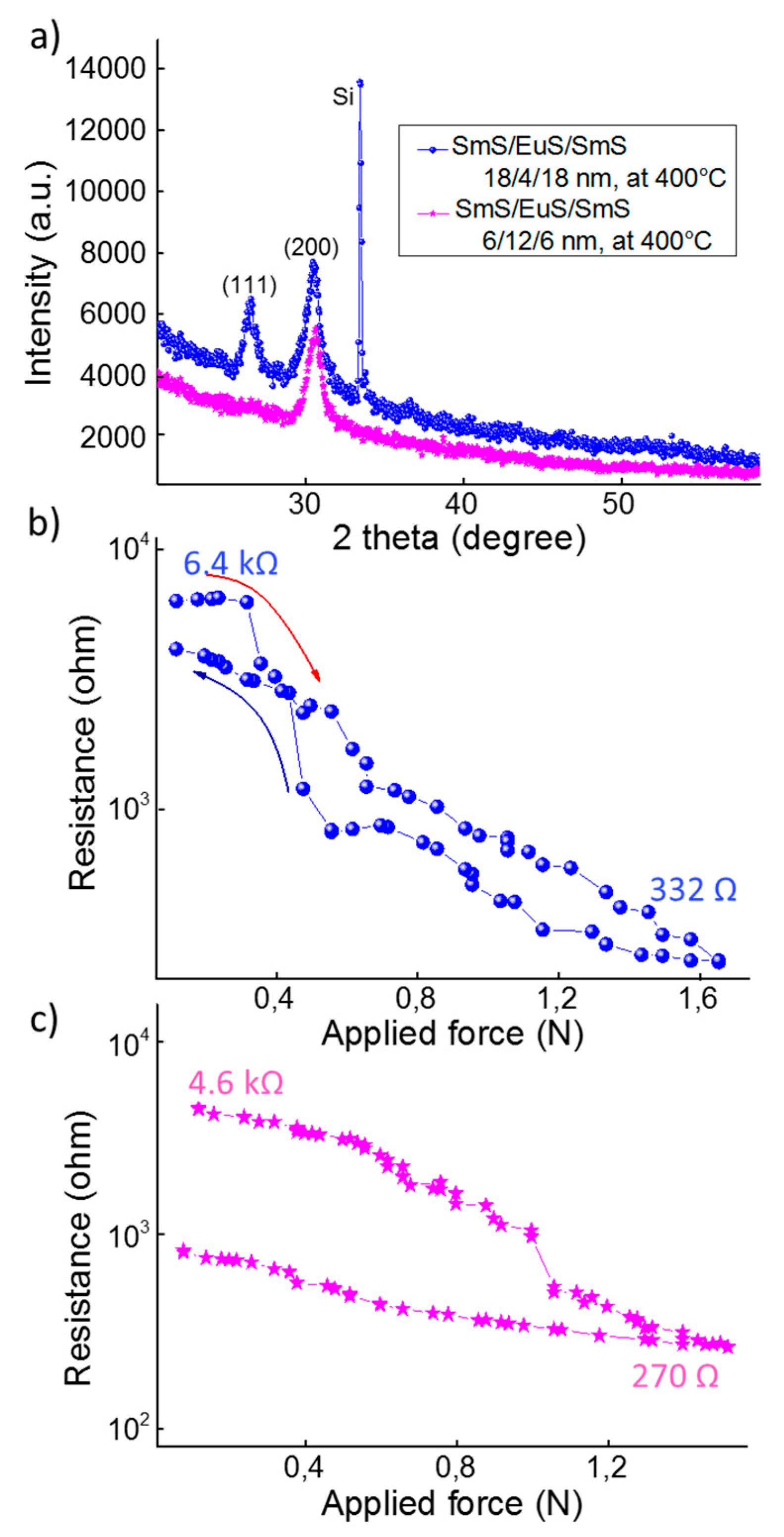
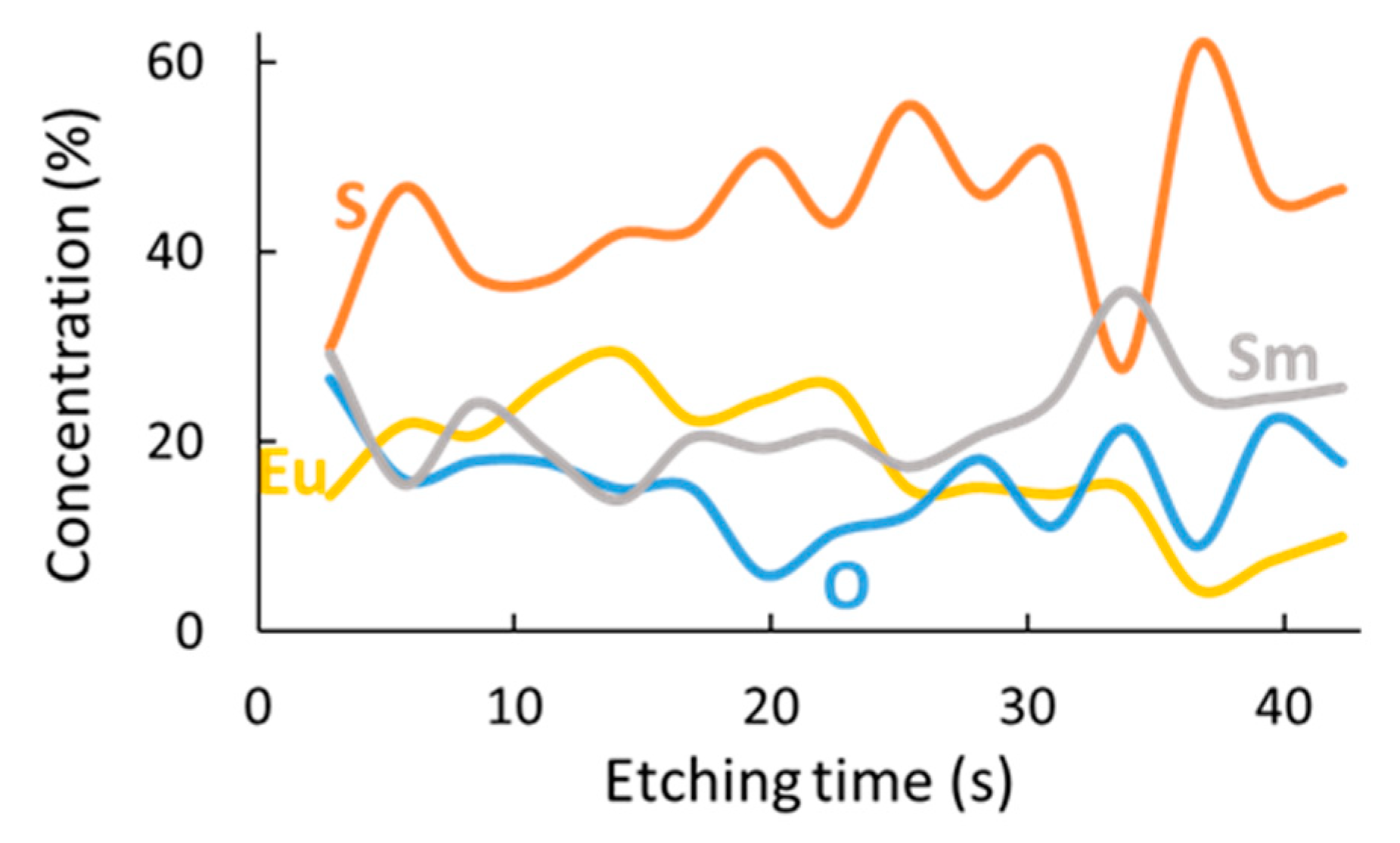
© 2019 by the authors. Licensee MDPI, Basel, Switzerland. This article is an open access article distributed under the terms and conditions of the Creative Commons Attribution (CC BY) license (http://creativecommons.org/licenses/by/4.0/).
Share and Cite
Sousanis, A.; Poelman, D.; Smet, P.F. SmS/EuS/SmS Tri-Layer Thin Films: The Role of Diffusion in the Pressure Triggered Semiconductor-Metal Transition. Nanomaterials 2019, 9, 1513. https://doi.org/10.3390/nano9111513
Sousanis A, Poelman D, Smet PF. SmS/EuS/SmS Tri-Layer Thin Films: The Role of Diffusion in the Pressure Triggered Semiconductor-Metal Transition. Nanomaterials. 2019; 9(11):1513. https://doi.org/10.3390/nano9111513
Chicago/Turabian StyleSousanis, Andreas, Dirk Poelman, and Philippe F. Smet. 2019. "SmS/EuS/SmS Tri-Layer Thin Films: The Role of Diffusion in the Pressure Triggered Semiconductor-Metal Transition" Nanomaterials 9, no. 11: 1513. https://doi.org/10.3390/nano9111513
APA StyleSousanis, A., Poelman, D., & Smet, P. F. (2019). SmS/EuS/SmS Tri-Layer Thin Films: The Role of Diffusion in the Pressure Triggered Semiconductor-Metal Transition. Nanomaterials, 9(11), 1513. https://doi.org/10.3390/nano9111513





